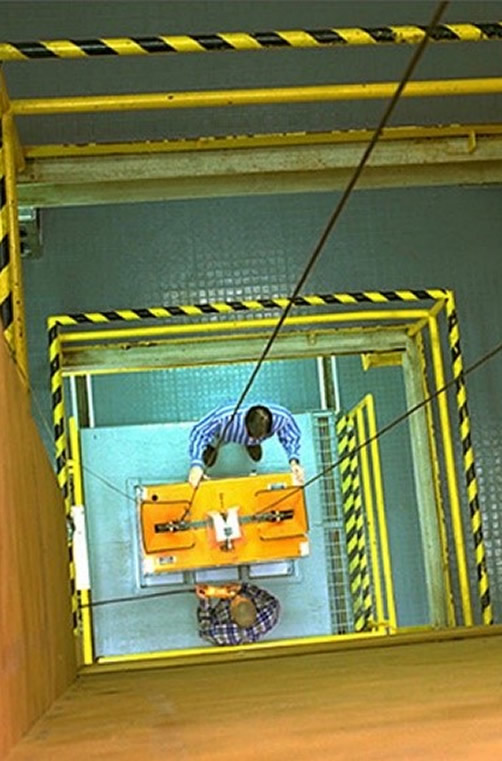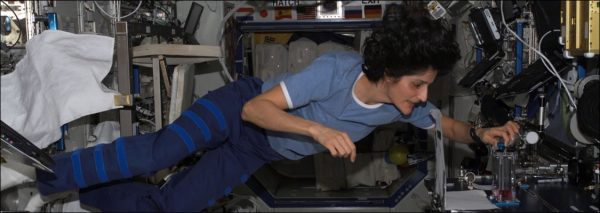CELERE – Capillary Effects on Liquids Exploratory Research Experiments
CELERE
An ISS Research Design Challenge
WHAT IS THE CHALLENGE?

CELERE is an educational program at NASA’s Glenn Research Center (GRC) enabling students to participate in microgravity research on capillary action related to that conducted on the International Space Station (ISS). Students create their own experiments using Computer-Aided Design (CAD) with a provided template and tutorial for the freely downloaded version of LibreCAD Software. Experiment proposals, which each consist of a single CAD drawing and short entry form, are e-mailed to NASA. The test cells are then manufactured by NASA engineers and scientists at no cost to the students using the drawings and a computer-controlled laser cutter.
Each experiment is conducted in Glenn Research Center’s Drop Tower, where it will fall 30 meters (100 feet) and experience 2.2 seconds of apparent near weightlessness, i.e., microgravity. Video and still images from each drop are provided online for each student or team for analysis and reporting of results, for example in a science fair or class presentation. NASA will review the final reports with the winning teams potentially earning free trips to a research conference.
WHAT IS CAPILLARY ACTION?
Capillary action happens when the molecules of a liquid (like water) are more attracted to a surface than to each other. In paper towels, the molecules move along tiny fibers. In plants (like celery), they move upward through narrow tubes called capillaries.
Capillary action can be difficult to observe on Earth because of gravity, except in small capillaries. But while experiments fall in a drop tower, where there seems to be almost no gravity, capillary effects are easy to see and study.
WHAT IS A DROP TOWER?

When an experiment falls down GRC’s Drop Tower (shown on the right from the 8th floor), it behaves as if gravity has nearly vanished – of course neglecting the fall! Our sensation of gravity and weight comes from a resistance to its pull, for example because of the floor holding us up. While freely falling, we feel weightless and that is the basis for many amusement park rides. This works because all objects fall at the same acceleration unless acted upon by another force. As one result, the astronauts and the ISS fall together (around Earth) such that the astronauts float within the space station. This happens even though the space station is so close to Earth that the gravity is only about 10% less than that on the planet’s surface.
WHO CAN APPLY?
The design challenge is for students in grades 8-12, who may participate as individuals or in teams of any size. Teams may include younger students as long as there is at least one team member in grades 8-12, where this can facilitate the participation of 4-H clubs, Scout troops, etc. The program is limited to students from the United States. It is open to all fifty states, the District of Columbia, Puerto Rico, American Samoa, Guam, the Northern Mariana Islands, and the U.S. Virgin Islands. Students in other countries – even if U.S. citizens – are ineligible, with the exception of those attending DODEA schools for the children of U.S. military personnel. Youth are free to get help from adults, for example in creating their CAD drawing.
WHAT FORMS DO I NEED?
In order to apply for this challenge you must review and complete the following:
WHAT IS THE CHALLENGE TIMELINE?
Proposals must be submitted to celere@lists.nasa.gov by TBD, where it is expected that the selected experiments will be conducted during that month. Written reports on the results are due to celere@lists.nasa.gov by TBD. Some participants will be invited to present their results at a technical conference on TBD.
WHERE IS THE CHALLENGE?
Students participate remotely, without traveling to NASA. But they can interact with NASA by e-mail or teleconferencing. However, some participants will be invited to present their results in a student poster session at the TBD meeting of the American Society for Gravitational and Space Research (ASGSR) on TBD. Limited financial support may be available for invited non-local teams to travel to Baltimore, Maryland for this purpose. It is envisioned that up to six teams will be invited to the conference, where three are local and three are non-local, e.g., from more than 150 miles away from the conference site.
WHY SHOULD I PARTICIPATE?
The design challenge enables students to learn about computer technology and participate in research related to space station science, both of which can inspire the pursuit of STEM careers. Scouting students could potentially use the CAD drawing toward completion of the Drafting merit badge. And selection in a nation-wide NASA design challenge is an accomplishment worth noting on college applications!
RESOURCES
Capillary Action Information
- http://water.usgs.gov/edu/capillaryaction.html
- http://web.mit.edu/nnf/education/wettability/index1.html
- http://hyperphysics.phy-astr.gsu.edu/hbase/surten2.html#c4
Microgravity Information
- http://www.nasa.gov/centers/glenn/shuttlestation/station/microgex.html
- http://www.nasa.gov/audience/foreducators/microgravity/home/index.html
LibreCAD Information
- LibreCAD – Free Open Source 2D CAD
- LibreCAD Tutorial
- CELERE Template
Other Challenge Documentation
- CELERE Entry form
- CELERE Handbook
FAQ
Q: What are the constraints for my design?
A: The design must have at least two channels and fit inside the predetermined area on the template. You must develop your design in such a way that it answers your research question while also being unique from previous designs (which can be viewed in the CELERE Handbook). In the drawing the lines must be created in the CUT layer, be continuous, extend from the template base to the green line, and be at least 3 mm apart. Further explanation of design constraints can be found inside the CELERE Handbook.
Q: Can I apply as an individual?
A: You can enter this challenge as either a member of a team or as an individual!
Q: Can I submit more than one experiment?
A: A student may be associated with at most one experiment, whether they do so as an individual or as a member of a team. Furthermore, a maximum of 7 experiment proposals may be submitted by a single school or organization for the challenge.
Q: How do I analyze my drop tower video?
A: In the CELERE Handbook there is a section detailing the steps to take to analyze your drop tower video using a free software program called ImageJ.
Q: Will I be able to make any changes to my design once submitted to NASA?
A: Once designs are submitted; they will be viewed for approval by the challenge experts. The tentative plan is to reject any submissions that violate the design guidelines without request for revisions. Make sure that your design meets all design specifications and constraints before submission.
Q: What am I not allowed to design?
A: You may not submit designs that violate the design constraints such as designs that have channel walls closer than 3 mm or designs that do not extend to the green section. Additionally, no one is allowed to submit designs that feature “islands” or chunks of uncut material inside the channels. Nothing, including text, can be placed outside of the designated location in the template.
Q: Is there any cost associated with participating in this challenge?
A: There is no cost to participate in CELERE other than the optional conference travel. The conference registration fee may be covered for the teams with the best final reports submitted to NASA.

FURTHER QUESTIONS?
E-mail the challenge staff at celere@lists.nasa.gov.
